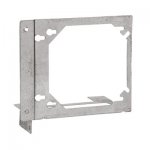I am an electrician at a university. I have been given the job of inspecting and reporting on how one of the projects being done by an outside contractor is doing. Because of pillars in the existing building, the decision was made to stud out the wall so that no pillars are visible. Thus the metal studs only have sheetrock on one side of the studs. The electrician started installing brackets that would work for where there is sheetrock on the other side of the wall. There is a metal brace that prohibits the box from moving back any farther. However, because there is nothing to push up against, the boxes could push back from the sheetrock. I brought this up long before there was any sheetrock on the wall. I sited the NEC 2020
I also sited
The electrical contractor claimed that the ears on the receptacle were part of the mounting. Is the contractor correct? Are there any other codes that would be helpful? Thank you for your input.
110.13 (A) Mounting Electrical equipment shall be firmly secured to the surface on which it is mounted.
I also sited
110.12 Mechanical execution of work. Electrical equipment shall be installed in a neat and workmanlike manner.
The electrical contractor claimed that the ears on the receptacle were part of the mounting. Is the contractor correct? Are there any other codes that would be helpful? Thank you for your input.

